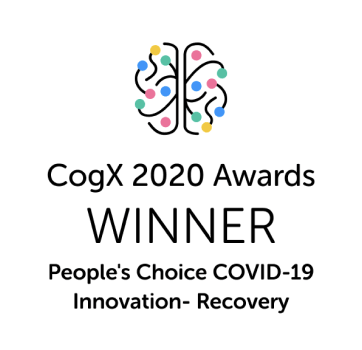As online learning continues to grow globally, learning management systems (LMS) are revolutionising how we learn. They offer a level of accessibility and flexibility that traditional classrooms simply can’t match, redefining how education is delivered and experienced.
And the numbers? They speak for themselves. With the global eLearning market growing at a solid 20% every year, LMS platforms are quickly becoming a must-have. In 2025, the LMS market cap is expected to reach $28.2 billion, serving over 75 million users worldwide.
Whether you’re an institute owner or managing a university, an LMS offers a tremendous opportunity to enhance your students' learning experience while unlocking significant growth potential for your business.
In this guide, we’ll delve into the key features your LMSs needs, types of LMS you can build and how you can create your own LMS using Builder.ai.
What is a LMS?
A learning management system is a software platform designed to create and manage content for educational courses. It serves as a centralised platform for educational institutions and businesses to provide online learning, track progress and collaborate with students. LMS makes learning more accessible and engaging for both students and professionals.
Why invest in an LMS?
When considering investing in an LMS, the question isn’t if you should be investing in it, but why? Investing in an LMS isn’t just about adopting technology — it’s about creating a tailored learning experience that meets your goals. It allows you to centralise training, streamline content delivery and personalise learning experiences, making sure better outcomes for both students and educators.
Here’s why it’s a game-changer:
- Enhanced learning - learners can access course anytime, anywhere
- Personalised learning experiences - LMS enables personalised learning journeys by adapting content to the pace, preferences, and needs of learners
- Scalability - a custom LMS offers more room to scale and adapt to your evolving educational or training needs.
- Data-driven insights - leverage advanced analytics to track engagement, measure outcomes and optimise programs for better results.
- Enhanced engagement - use interactive features like videos, gamification and quizzes to keep learners motivated and ensure better knowledge retention.
Types of LMS
LMSs come in various types, each designed to cater to specific use-cases and environments. Here’s a detailed look at the different types of LMS:
1 - Cloud-based LMS
Cloud-based LMS solutions are hosted on the provider’s servers and accessed through the internet. They're known for their scalability, ease of use and minimal IT involvement.
This type of LMS is ideal for organisations looking for a plug-and-play solution with minimal technical overhead. For instance, a company launching a global employee training program can use a cloud-based LMS to quickly onboard users without worrying about server capacity or maintenance.
Advantages
- No installation or maintenance required
- Automatic updates and support provided by the vendor
- Scalable to adapt to growing user needs
2 - Self-hosted LMS
A self-hosted LMS is installed on the organisation’s servers, giving complete control over customisation and data management. This type of LMS is ideal for organisations needing deep customisation or those with strict data security policies. For instance, a university with unique grading and course management requirements may choose a self-hosted LMS to tailor the platform to its needs.
Advantages
- Full control over system functionality and data
- Highly customisable to meet specific requirements
3 - Open-source LMS
Open-source LMS platforms are free to use and modify. They provide the flexibility to tailor the software to specific needs but require the technical expertise for implementation and maintenance.
This is best suited for institutions or businesses with limited funding but have internal technical teams that can customise the platform. Popular open-source LMS are Moodle and Open edX.
4 - Corporate LMS
Corporate LMS platforms are tailored for businesses to address training, compliance and employee development needs. Companies focused on professional development and enhancing workforce skills generally opt for this type of LMS.
For instance, a retail company can use a corporate LMS to train staff on new product lines and customer service techniques, ensuring consistent quality across locations.
Advantages
- Features for skill development, compliance tracking and performance analytics
- Supports ROI measurement for training programs
5 - Academic LMS
Academic LMS platforms are specifically designed for educational institutions such as schools, colleges and universities. This type of LMS works great for educational institutions focusing on structured curriculums and student performance tracking.
Advantages
- Tools for course management, grading and teacher-student communication
- Supports structured learning paths and collaboration
Must-have features in an LMS
To create a learning management system, you need a list of key features. These may include:
1 - User-friendly interface
An intuitive design makes sure learners can navigate the platform easily. Simple dashboards, clear menus and search functionality enhance the user experience (UX) and reduce the learning curve.
2 - Course management
Efficient course creation and management tools allow instructors to design courses, add multimedia content, set learning paths and update materials easily. Features like pre-built templates and drag-and-drop editors streamline the process.
3 - Personalised Learning
Customised learning paths help cater to individual learner needs, enabling them to progress at their own pace while focusing on areas requiring improvement.
4 - Offline accessibility
Offline compatibility ensures learners can access courses anytime, anywhere without an internet connection.
5 - Assessment tools
Built-in tools for assignments and exams help evaluate learner progress. Automated grading, feedback and certificates of completion add value to the learning experience.
6 - Gamification
Incorporating gamification features like badges, leaderboards and rewards boosts motivation and engagement, making learning more enjoyable.
7 - Integration
The ability to integrate with other tools such as CRM systems, HR software and video conferencing platforms like Zoom ensures seamless operations and better productivity.
8 - Reporting and analytics
Detailed insights into learner progress, engagement and performance metrics help administrators optimise courses and track overall success. Visual dashboards make data easy to understand.
Who should you choose to build your LMS?
There are many ways you can create a learning management system. If you’re a programmer, you could create one yourself. Just remember, this might take a while. A typical LMS could have thousands of lines of code.
Alternatively, you can hire a team of mobile app developers, as they can build robust LMS with a range of custom features. However, the challenge here is to accurately calculate the total cost of app development.
They often charge on an hourly or daily basis, and once you factor in the costs of app development, design, app testing and listing, the expenses quickly spiral out of control.
No-code app builders are a simpler, more budget-friendly solution. You don’t need coding skills to use them and you can build apps quickly by dragging and dropping pre-made components.
However, no-code platforms may lack the flexibility to add complex features or unique customisations, and scaling the app as your user base grows can be problematic due to performance limitations.
This is where Builder.ai comes in 👇
Create robust custom software today
100s of businesses trust us to help them scale.
Book a demoBy proceeding you agree to Builder.ai’s privacy policy
and terms and conditions
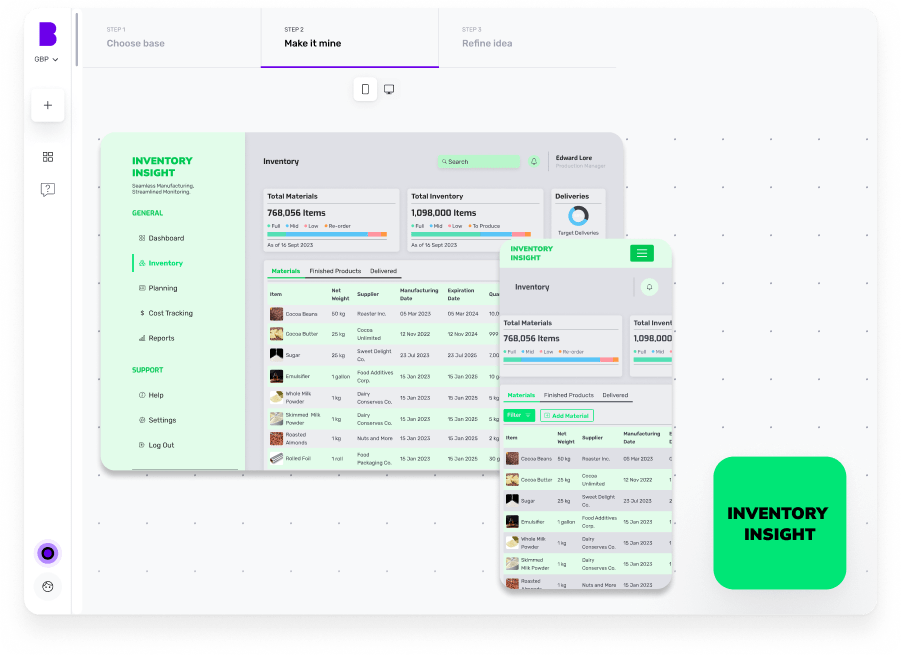
Why Builder.ai is different?
Builder.ai offers the best of both worlds by providing a solution that bridges these gaps. It provides the customisation and scalability of professional developers along with the efficiency and cost-effectiveness of no-code builders, making it an ideal choice for developing your learning management system.
Around 80% of all software is made up of around 650+ features. We package each basic feature as a reusable Lego-like block. Explain your idea to our AI companion, Natasha, and she uses these blocks to rapidly create an outline of your software.
The work is completed faster and cheaper because Natasha handles all the repetitive coding. Then it’s off to our app design team and mobile app developers. They personalise it and create any bespoke elements you need.
To build your LMS, simply head over to Builder Studio. The Builder Studio platform has been built with user convenience in mind and intuitively guides you through the app creation process.
Let’s dive in with the step-by-step process 👇
1 - Discuss your ideas with Natasha
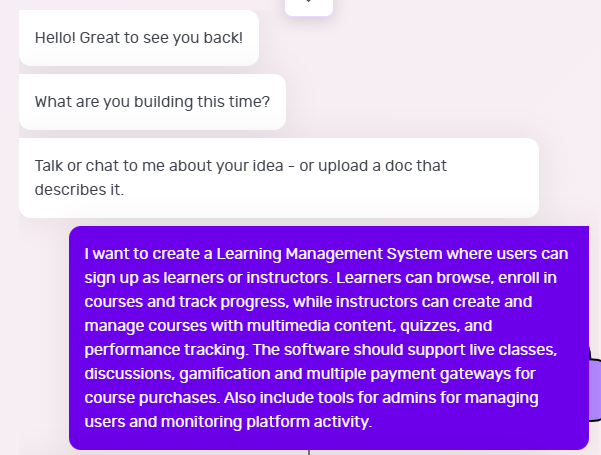
On Builder Studio, you’re greeted by Natasha. You can express your LMS idea to Natasha via voice, text or uploading a PDF or doc file.
Before you chat with her, have a checklist of app features and be as descriptive as possible about your app idea. The more detailed information you give to Natasha, the better her suggestions will be.
For instance, a prompt could look like this:
“I want to create a Learning Management System where users can sign up as learners or instructors. Learners can browse, enrol in courses and track progress, while instructors can create and manage courses with multimedia content, quizzes, and performance tracking.
“The software should support live classes, discussions, gamification and multiple payment gateways for course purchases. Also include tools for admins for managing users and monitoring platform activity. “
Based on your prompt, Natasha will ask you some supporting questions and you simply need to answer them based on your requirements.
2 - Choose a base
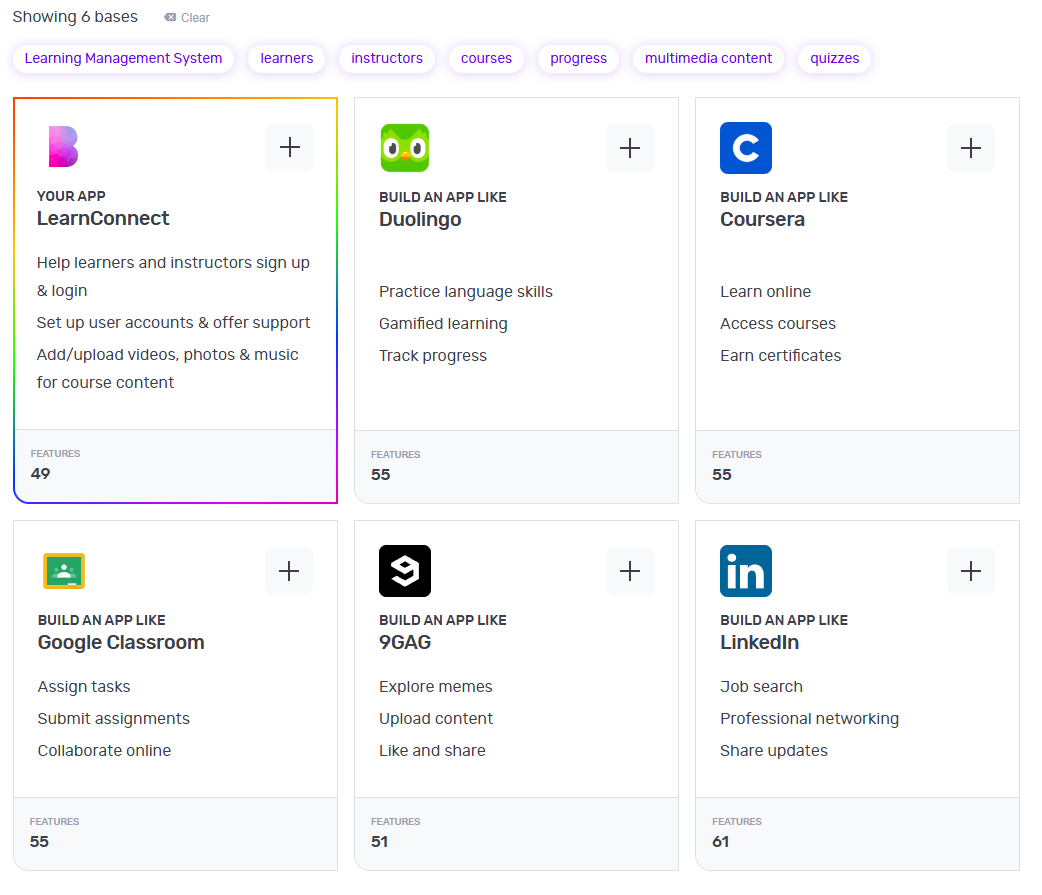
Once you’ve provided your requirements to Natasha, she’ll create a custom framework for your platform based on everything you tell her. She'll also suggest some pre-built bases she thinks are best suited for your platform.
For instance, in the above image, once you tell her to create an LMS, she’ll suggest a custom base similar to Coursera, Google Classroom and share any matching core bases as well.
You can choose up to 3 you feel are related to your big idea by simply clicking the ‘+’ icon. These selections make it easier for us to understand the features your app needs. When you’re ready, click 'Next'.
3 - Make it mine
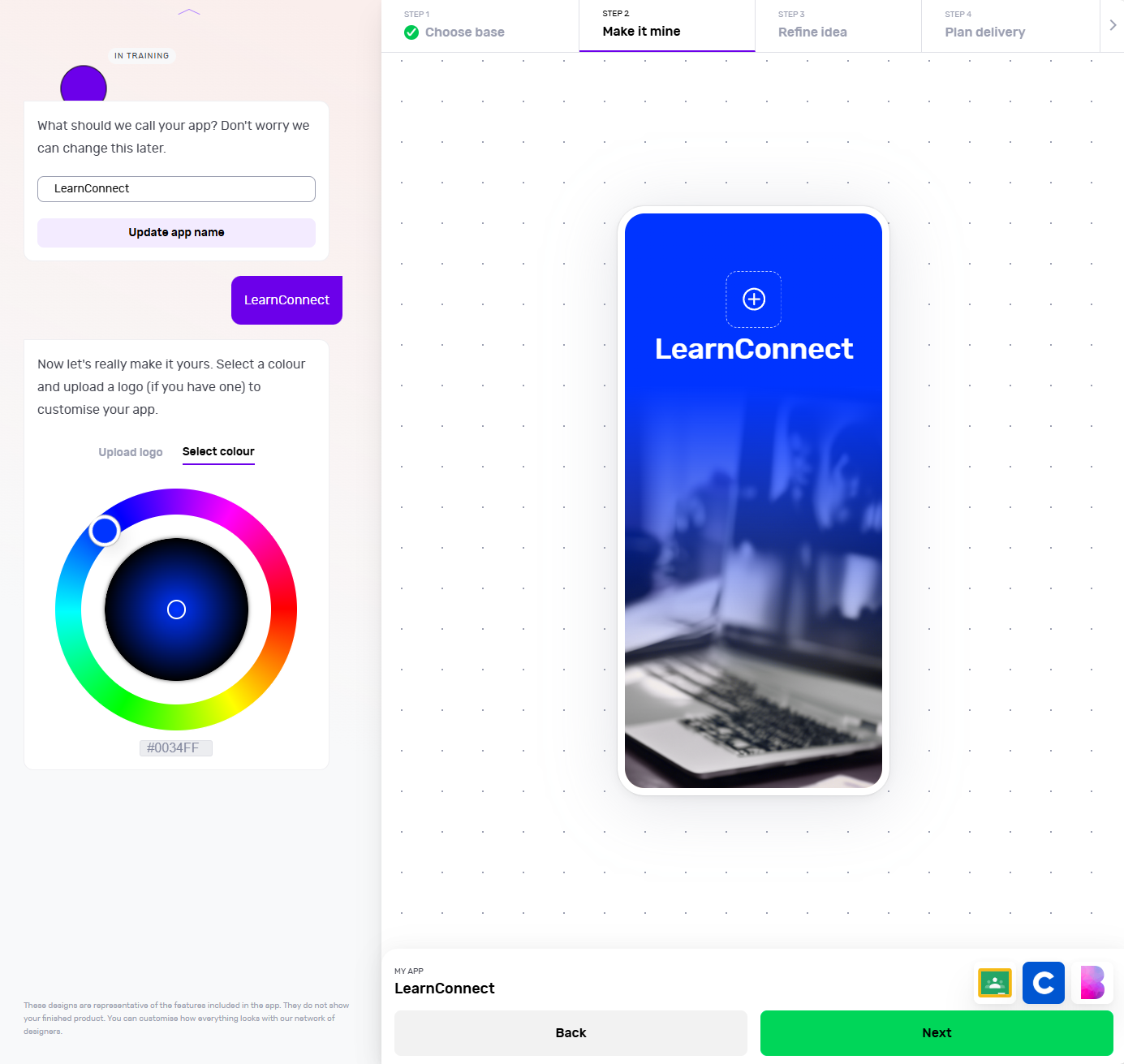
The 'Make it mine' step aligns your app with the identity of your brand. In this step, you can give the name to your app, choose the colour scheme using the colour wheel and upload the logo of your brand.
If you already have a website, you can add the link and Builder Studio will automatically pick your brand’s colours and logo.
Once you’ve personalised your app’s name, colour and logo, you can click ‘Next’.
4 - Refine your app idea
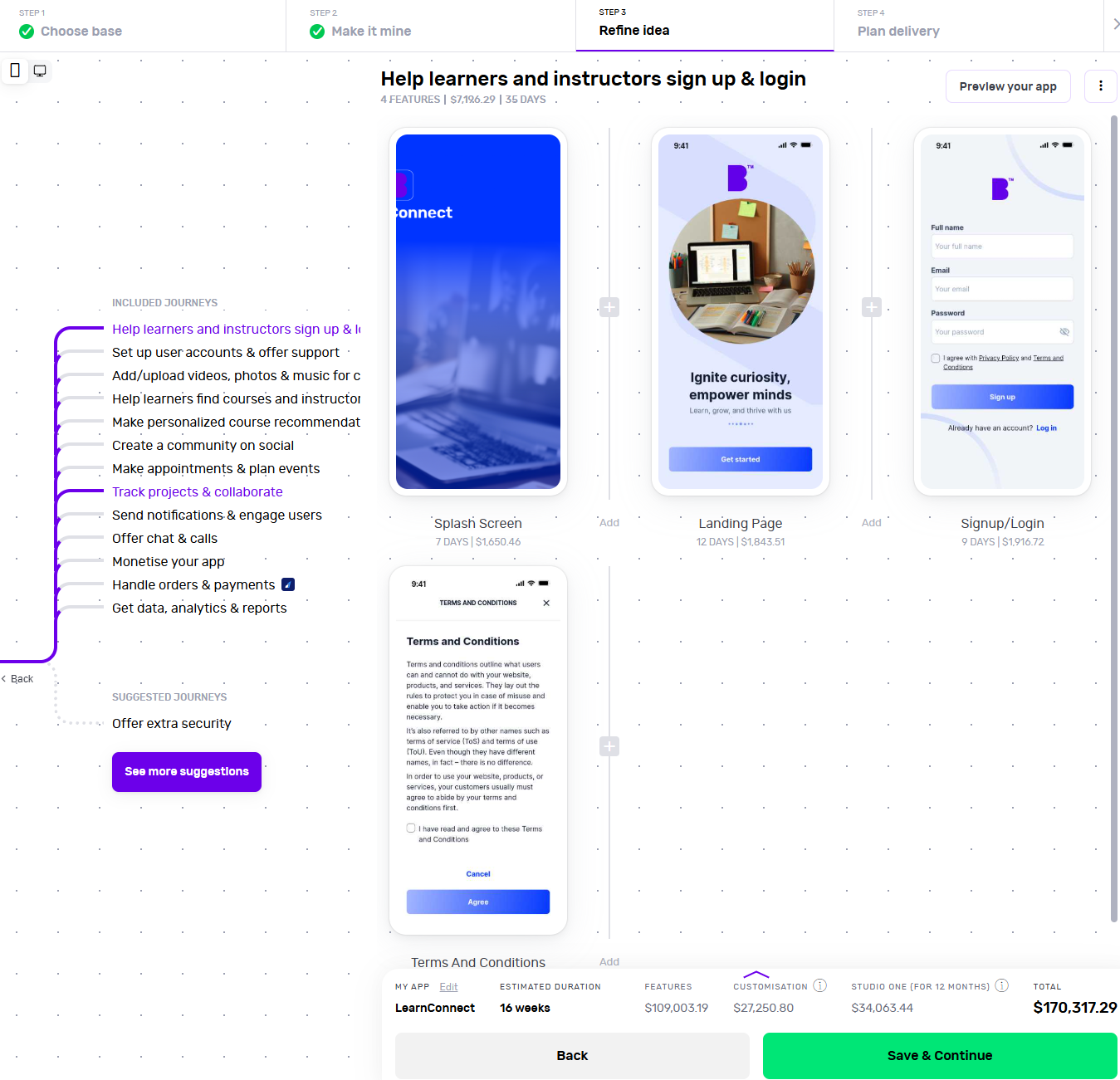
Now comes the fun bit.
In the 'Refine idea' stage, you can review and customise your app journeys and features and also create an instant prototype of your app.
Journeys
In a matter of seconds, Natasha creates app user journeys with corresponding features.
Go through these journeys carefully and see if your app needs additional journeys. For instance, check if you want to add journeys for monetisation, sending notifications or any other relevant journey.
To add journeys, click on 'See more suggestions'. Doing so will open the list of pre-built journeys. You can browse the list and select the journeys you’re missing. You can also add custom journeys by clicking on 'Add custom journey'.
Features
By clicking on individual journeys, you can see the feature list each journey contains. You can scroll through the features list and check if a journey contains non-essential features or if you want to add extra features.
To remove a non-essential feature, you can hover over the feature and click ‘Remove’. This way you can manage project costs. If you’re not sure what features to remove, you can click on individual features and check the label at the top. We highly recommend keeping the ‘Essential Features’.
In case you want to add more features, you can simply click the ‘+’ button. Clicking the ‘+’ button will take you to the list of pre-built features. Here you can go through different categories or use the search bar to look for missing functionality. In case you don’t find the feature you’re looking for, you can also add a custom feature by clicking on 'Add custom feature'.
Instant prototype and user flow
Once you’re happy with the journeys and features of your app, you can create a prototype by clicking on 'Preview your app' in the top-right corner.
Sign up and Natasha will create a working prototype of your app. You can click on the screen at different areas to progress through the journey.
You can also see the user flow by clicking on the 'Flow mode' at the top of the screen to see how users will interact and navigate within your app.
If you need extra help, Natasha is on hand to help and you can interact with her at any time by clicking on 'Speak to Natasha'.
She’ll provide you with suggestions and help you find features or journeys from the library. Or you can click on 'Book a demo' to talk to our product managers who’ll guide you through your app development journey.
Click on 'Save & Continue' to go to the next step and also to save your progress or it might get lost.
5 - Plan delivery
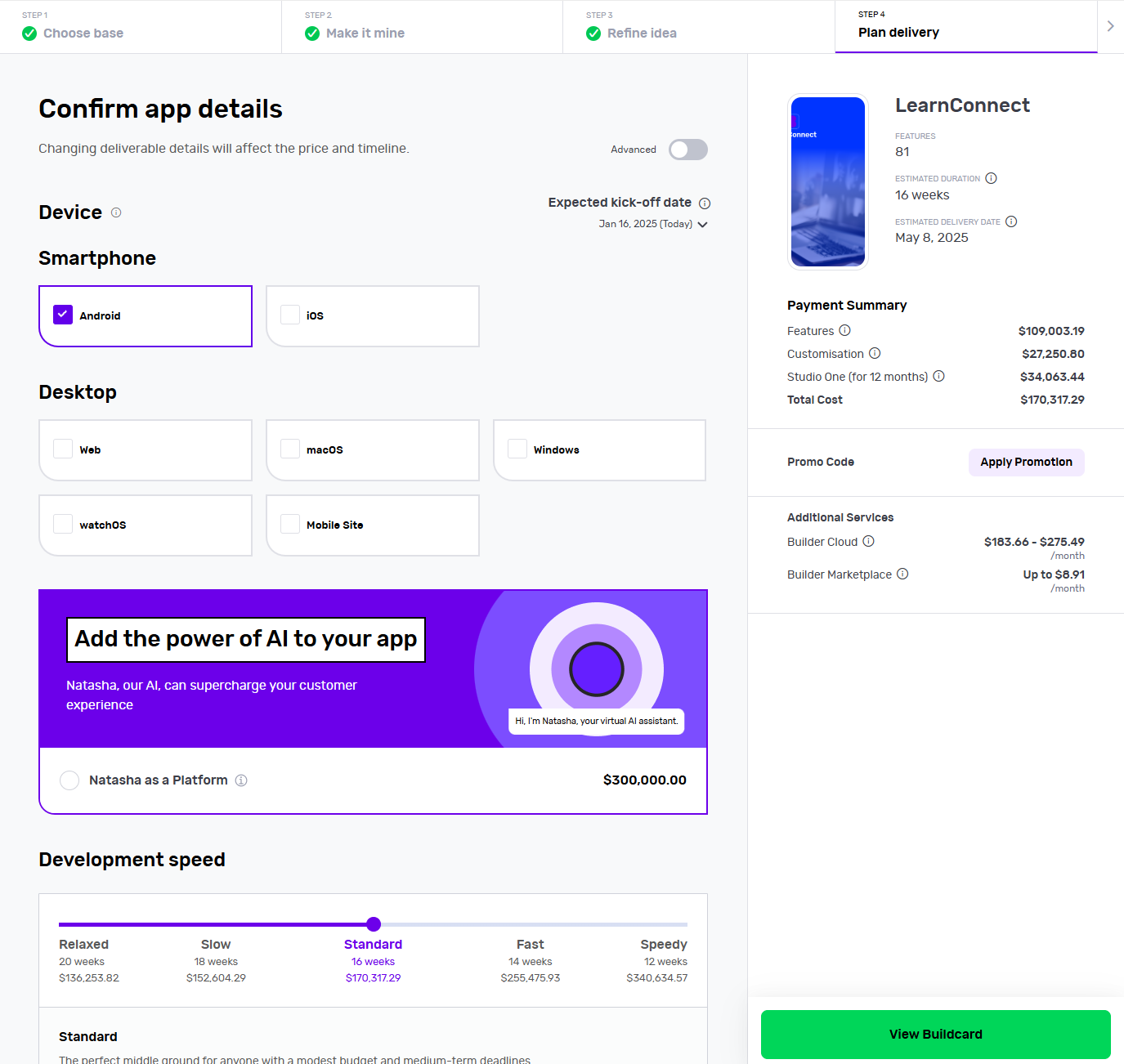
It’s time to choose the platforms you want your LMS to be available on. Want a LMS iOS app? Click iOS. Fancy an Android app? Hit Android. Not sure whether Android or iOS is better? Choose both to develop simultaneously and see how it changes the price and timelines.
Next, you can choose to add Natasha to your platform to supercharge the customer experience of your LMS platform. Natasha uses Large Language Models (LLMs) to engage your customers in fluid, human-like conversations.
Need more control? In the development speed, you can change the speed of each phase. Need it super fast? Pay extra and we’ll make it happen. No rush? Great, you can make big savings with relaxed timelines.
Next up is Design. If you have your app designs ready, you can save your costs by clicking 'You have design' and we’ll reduce your costs accordingly. You can share your design files (preferably in Figma) and our designers will upload them, so you can kick off straight away.
If not, you can choose the 'We do your designs'. Here, you simply need to add your brand assets and we'll do everything from storyboarding to fully designed screens.
Now it’s time to plan the phases of your project. Here you get three options:
- Clickable prototype: you’ll get a visual representation of your app to test with users
- Basic build: you’ll get an MVP (Minimum viable product) – a hard-coded but simplified version of your idea; this allows you to collect feedback and iterate before you do a full build
- Full Build: you’ll get market-ready software, including a kick-off with our product team and review sessions
After that, you need to select your support plans. With 'Full Build' you get one year of Studio One support included free of charge.
Once you’ve planned your delivery, click on 'View Buildcard'.
6 - Review Buildcard
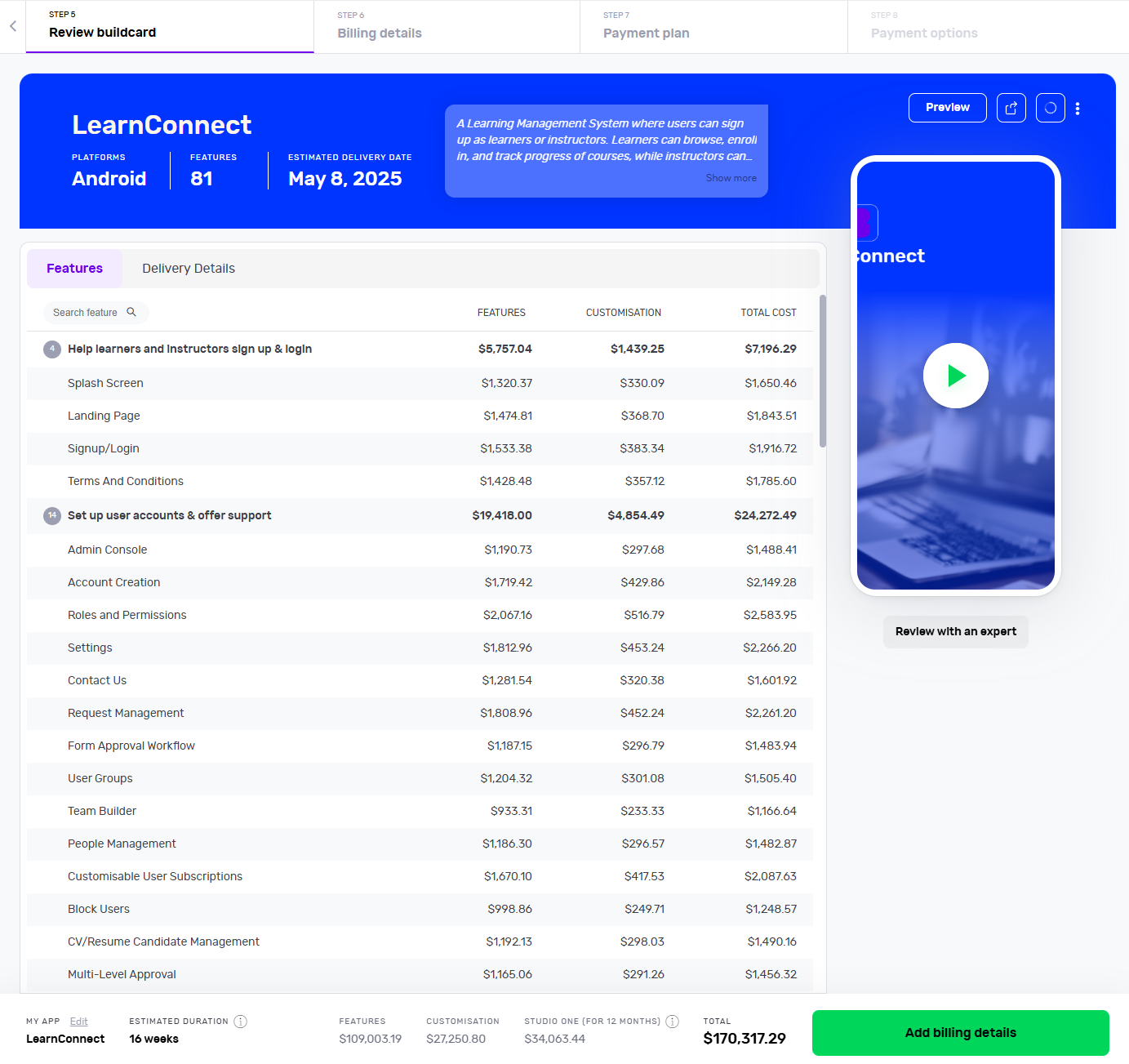
Buildcard provides you with a bird's eye view of all the selections you made in the previous steps. Here, you can review all the features, cost per feature and delivery details.
You can also download the PDF of Buildcard or invite others to show your team members what you’re building.
If you want to make any changes, simply click on 'Edit Buildcard' under three dots in the top-right corner.
If you’re happy with everything, click on 'Add billing details' to go to the next section. Alternatively, if you want to review it with experts, click on 'Review with an expert'.
7 - Select your payment plan
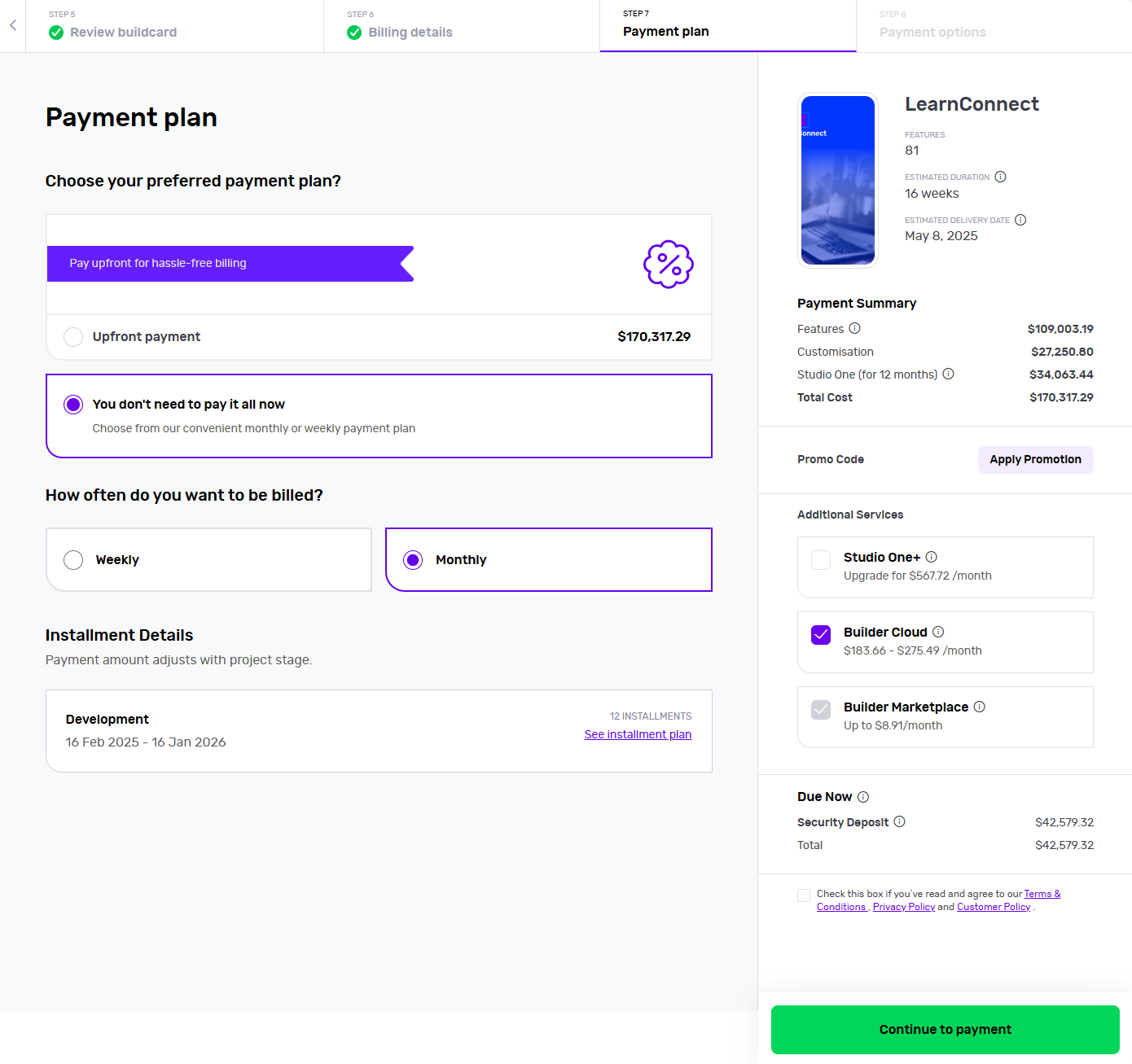
We offer weekly or monthly payment instalments, with visible payment dates and amounts for each option. You can also choose to pay upfront to reduce the cost of your build.
Simply select your preferred billing cycle, then click 'Continue' to proceed.
You’ll be asked to input your payment details and agree to the terms and conditions. Once that’s done, click 'Continue to Payment'.
When your payment is complete, you can set up a meeting with our product managers to begin your app development.
8 - Monitor your app build in real-time
With Builder Home, your real-time project dashboard, you can monitor development progress and make sure your app is exactly the way you want it.
This includes access to a suite of collaboration tools to help improve your app design. You can chat with your team of experts in Builder Meet, brainstorm in Builder Whiteboard and visualise your ideas with free Tailor-made prototypes from Builder Now.
Conclusion
Now that you know the importance of learning management systems in modern education, it’s worth building your own LMS. With the right features and user-centric approach, your LMS can be highly beneficial for your business.
This is where Builder.ai comes into play. We simplify the software development process and make it accessible to even those with limited technical knowledge. With us, you can bring education to millions of people and open new doors for learning something new..
If that sounds good, hit the banner below and kick off your learning management system project with us today 👇
FAQs
Q1 - How do I decide on the core features for my learning management system?
You need to identify your audience's needs, such as course creation, progress tracking or interactive content. Focus on features like user management, multimedia support, analytics and payment options. Prioritise functionalities that enhance learning experiences and meet your organisation’s specific objectives.
Q2 - What are the different types of learning management systems available?
There are many types of LMS:
- Cloud-based LMS
- Self-hosted LMS
- Open source LMS
- Corporate LMS
- Academic LMS
Q3 - Can I build a learning management system prototype without technical skills?
Yes, you can! With our free prototyping tool, Builder Now, you can create a clickable mockup of your idea in under 10 minutes. Experiment with the flow of your app and share it with friends, customers or investors for feedback.
Q4 - Why should I choose Builder.ai to create my LMS?
Builder.ai offers a fully managed service, meaning there's zero learning curve and no drag-and-drop dread. You can build sophisticated platforms with custom functionalities with us in comparison to the rigid templates used by other no-code/low-code app builders.
When you work with Builder.ai, your app development cost is finalised before your project starts in a Buildcard, which lists every feature that makes up your app. Because this process is handled up front, you receive a guaranteed pricing plan for your app project, meaning there are no nasty surprises down the line.
What’s more is you keep your code once your two-year payment plan is complete, making it easy to migrate your app to another platform or add custom features to meet emerging business needs.
Finally, we bundle in an app maintenance service for the first year of your project, ensuring your app and website stay up-to-date, bug-free and secure.
Q5 - How much does it cost to build an LMS?
Builder.ai gives you custom pricing for your learning management system project because we charge per feature. Our AI fits all your features together and lists all your app development costs in a Buildcard before you pay for your food delivery app, so there are never any uncalled surprises.
Create robust custom software today
100s of businesses trust us to help them scale.
Book a demoBy proceeding you agree to Builder.ai’s privacy policy
and terms and conditions

Gaurav is the SEO Content Writer at Builder.ai. Being an Engineer and Marketing MBA, he has a knack for converting technical jargon into marketing content. He has 8+ years of experience creating content and designing marketing campaigns that drive organic growth for B2B companies and tech startups.

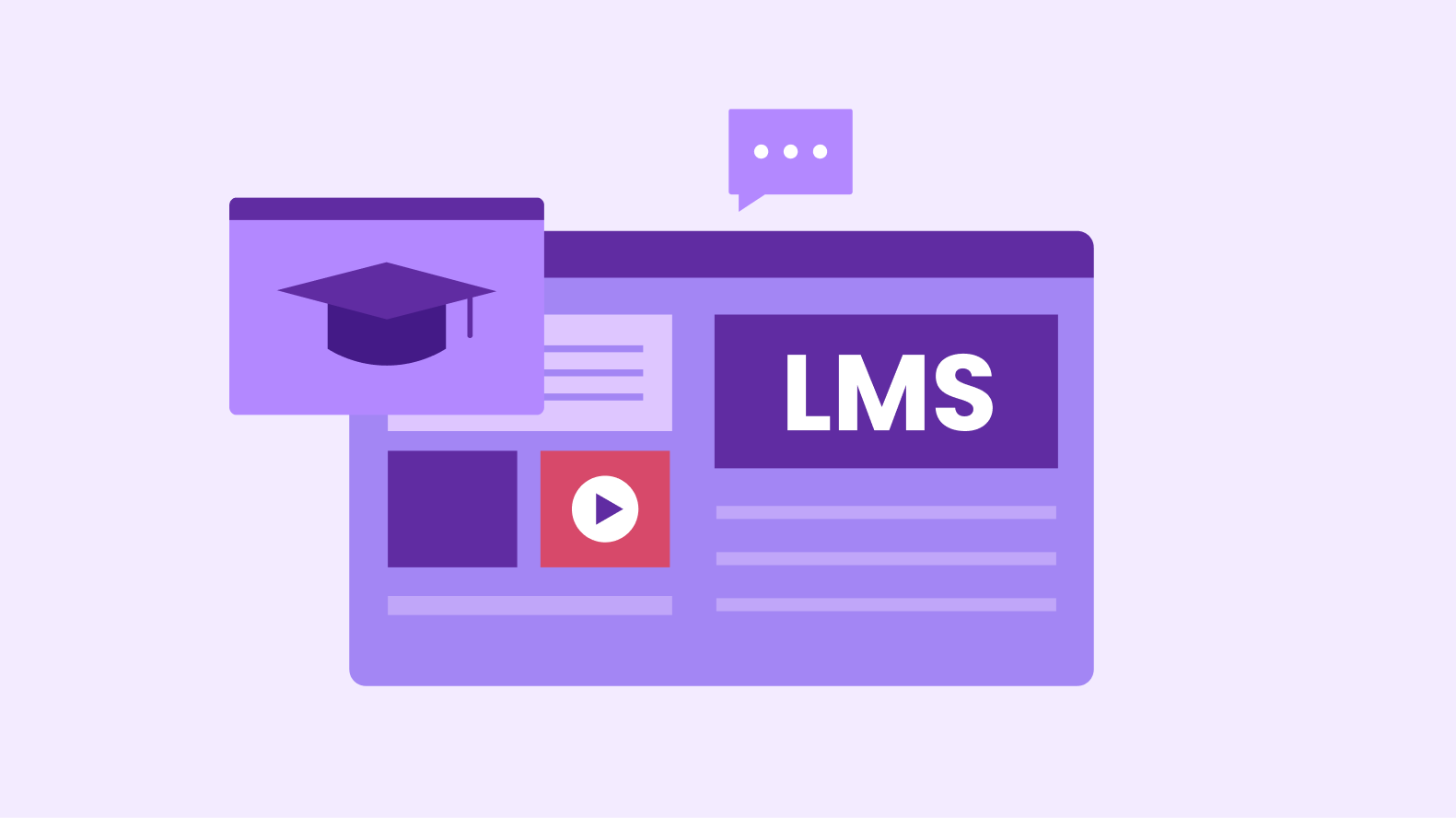


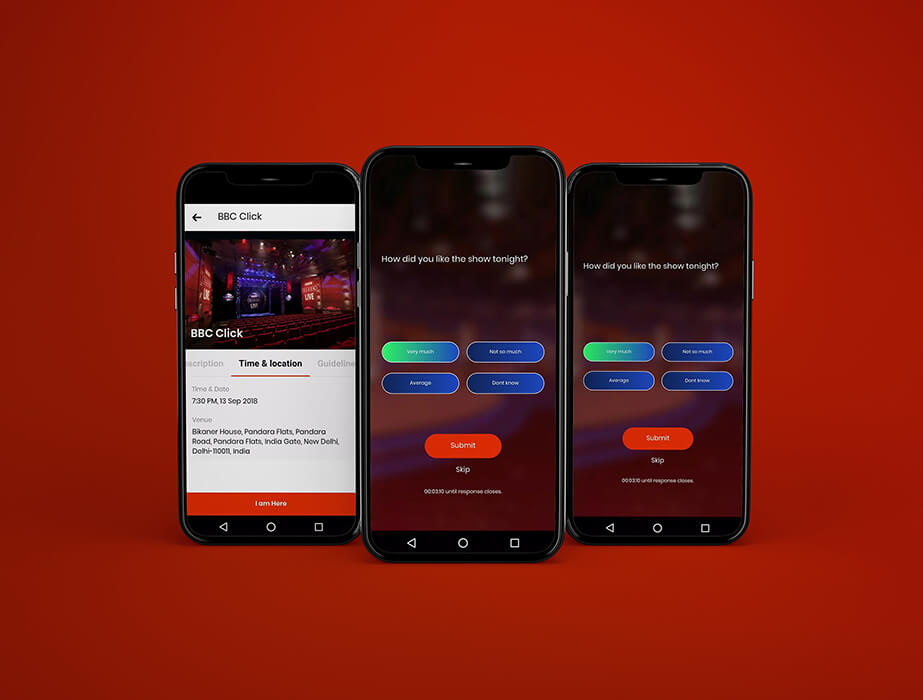

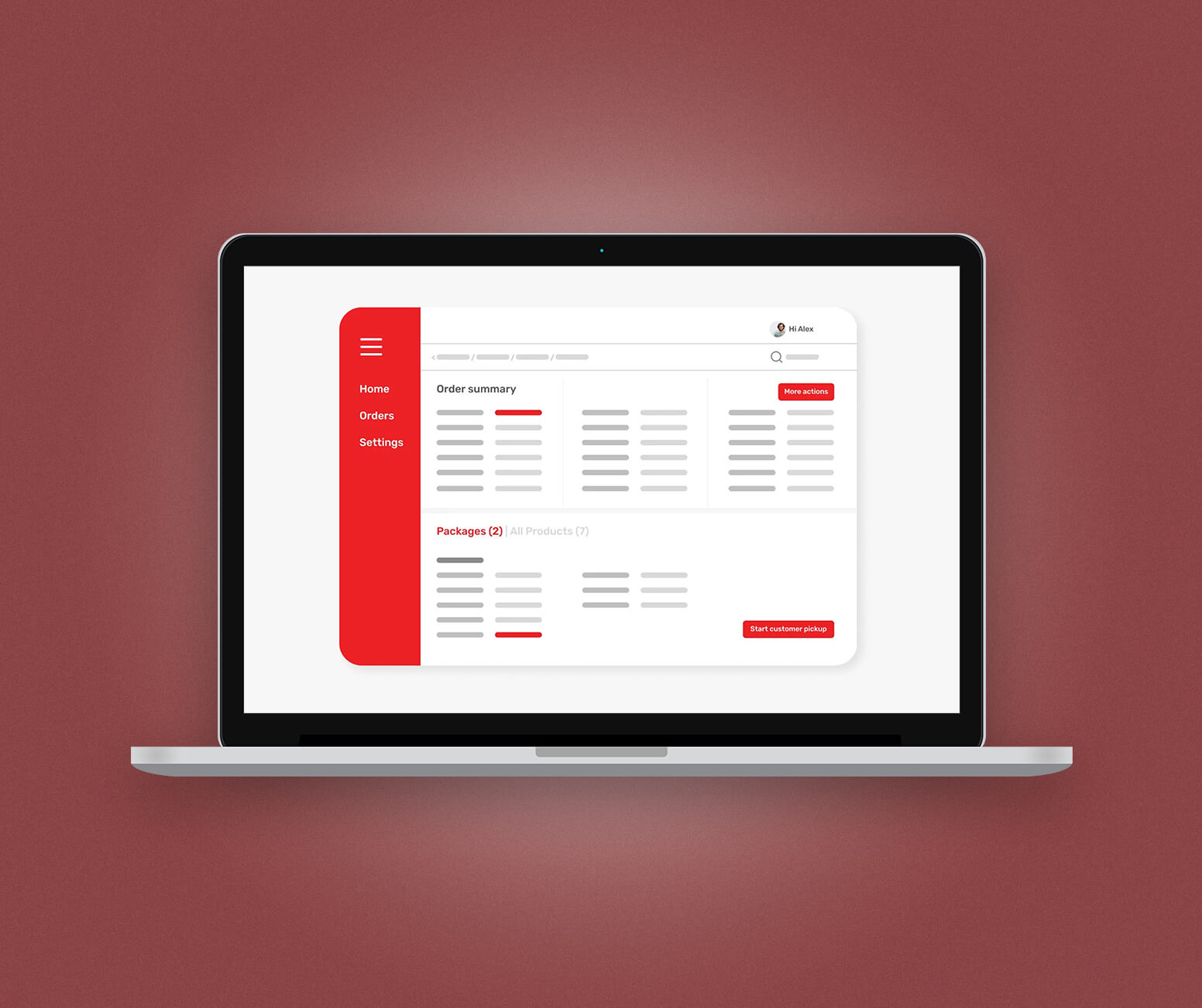

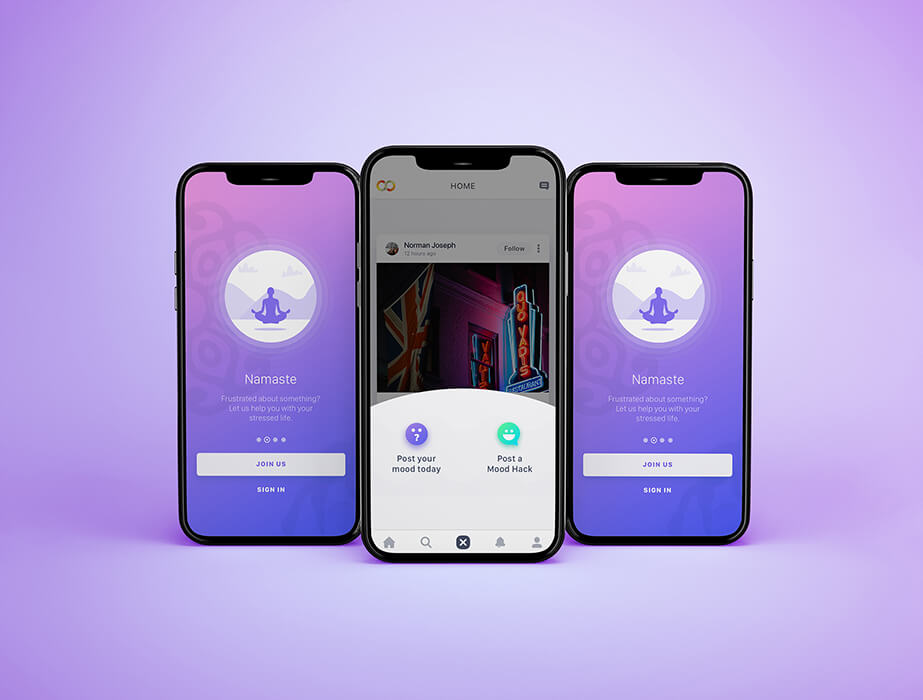

 Facebook
Facebook X
X LinkedIn
LinkedIn YouTube
YouTube Instagram
Instagram RSS
RSS
